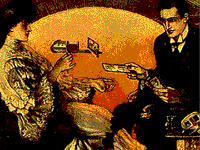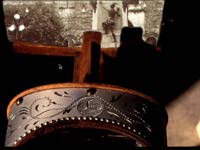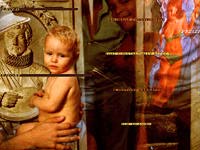


Biography
Esther Parada is an artist/photographer, teaching in the School of Art & Design, University of Illinois at Chicago. During the late 70s and early 80s she interwove fragments of her family history through a series of large-scale photo-composites, including "Memory Warp" and "Past Recovery." Since 1986 she has used digital technology to create a number of photo-montage and photo-text works which reflect on the relationship between historical/cultural representation and power. These works, including "The Monroe Doctrine: Theme and Variations," "Define/Defy the Frame," "A Thousand Centuries," and "At the Margin," may be seen in various publications such as In Our Own Image: The Coming Revolution in Photography (1990, Aperture Press); Iterations: The New Image, (1993, International Center of Photography with MIT Press); History of Women Photographers (1994, Abbeville Press); and A World History of Photography (Abbeville Press, 1996). Parada's website "Transplant: A Tale of Three Continents" was created in 1997 for inclusion in La Finca/The Homestead: A Colony in Cyberspace, organized by Paul Hertz of Northwestern University for the University of Valencia, Spain. (http://www.rtvf.nwu.edu/Homestead/anywhere.html). Parada's most recent work is an installation (and offset lithography posters) titled "Canopy: A Meditation on the Demise of the American Elm," created during her 1997-98 residency at the Bunting Institute of Radcliffe College, Cambridge, MA.
She is a recipient of National Endowment for the Arts Photography Fellowships in 1982 and 1988; and she has exhibited extensively in the United States, as well as several Latin American and European countries. Her work is represented in the permanent collections of the Art Institute of Chicago, the Museum of Modern Art in New York City, and the Museum of Fine Arts in Houston, among others. Her critical essay "C/Overt Ideology: Two Images of Revolution" is anthologized in The Contest of Meaning, published by MIT Press (1989).
Conceptual Description
"The stereograph, as we have called the double picture designed for the stereoscope, is to be the card of introduction to make all mankind acquaintances."
Oliver Wendell Holmes wrote these words in an essay for The Atlantic Monthly magazine in 1859, over one-hundred and thirty years ago. He was excited by what were then the new technologies of photography and stereography. In his vision they held a stunning promise of understanding among people from all parts of the globe. In the CD-ROM which takes its title from the Holmes quotation, "To Make All Mankind Acquaintances," I take a critical look at the nature of this cross-cultural communication, fostered through photography. In particular I am interested in the images of Latin America created and circulated through U.S. stereographs in the late 19th and early 20th centuries. This work grew out of my opportunity to explore the Keystone-Mast Collection at the California Museum of Photography in 1991 (during a residency organized by Edward Earle, as part of a Visual Artists Forum project: Photography and Society: New Imaging Technologies). The CD also includes background material on the Keystone Collection and on other personal and social histories which have influenced U.S. images of Latin America. Each major section of the CD-ROM is introduced by a quotation from Oliver Wendell Holmes's 1859 essay, inviting comparison of 19th century thinking on technology and representation with current attitudes.
1. THE KEYSTONE COLLECTION "Such are the stereoscope and the photograph, by the aid of which form is henceforth to make itself seen through the world of intelligence, as thought has long made itself heard by means of the art of printing...." (Oliver Wendell Holmes) This section describes the business of producing and selling stereographs. Whether marketed as entertainment or education - stereograph companies presumed to offer you the world in your hands, from the comfort of your fireside - an offer which resonates with contemporary claims for print, video and digital media.
2. TWO PARADIGMS OF REPRESENTATION, PART ONE: IDEALIZATION (PARADA) "Oh, infinite volumes of poems that I treasure in this small library of glass and pasteboard! I creep over the vast features of Rameses, on the face of his rock-hewn Nubian temple....I pass in a moment, from the banks of the Charles to the ford of the Jordan, and leave my outward frame in the armchair at my table, while in spirit I am looking down upon Jerusalem from the Mount of Olives." (Oliver Wendell Holmes) This section describes the romanticism of my photographic practice and egalitarian attitudes as a Peace Corps volunteer in Sucre, Bolivia in the mid-60s, followed by multiple critiques of that liberal documentary practice.
3. TWO PARADIGMS OF REPRESENTATION, PART TWO: PATERNALISM (BOYCE) "We have got the fruit of creation now, and need not trouble ourselves with the core. Every conceivable object of Nature and Art will soon scale off its surface for us. Men will hunt all curious, beautiful, grand objects, as they hunt the cattle in South America, for their skins, and leave the carcasses as of little worth...." (Oliver Wendell Holmes) This section describes an unquestioning faith in the superiority of U.S culture, and the inevitability of U.S. imperialist expansion, as manifested in the photographs and writings of Chicago entrepreneur William Boyce's 1914 book, United States Colonies and Dependencies, as well as in other sources of the period such as political cartoons.
4. INCIDENTAL TRUTHS: QUESTIONING THE MASTER NARRATIVE "This distinctness of the lesser details of a building or a landscape often gives us incidental truths which interest us more than the central object of the picture...." (Oliver Wendell Holmes) This section traces the development of two digital photography installations ("A Thousand Centuries" and "At the Margin"), which I created as a response to what I call "the master narrative," embodied by a series of Columbus monuments from the Keystone Collection.
